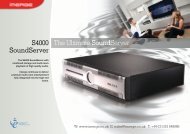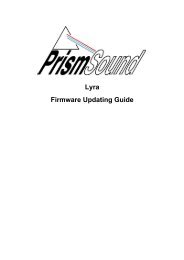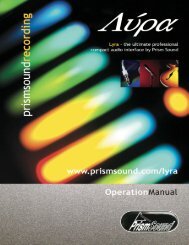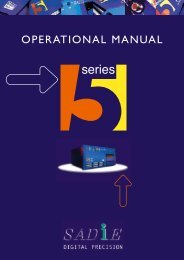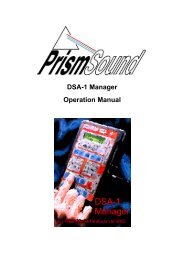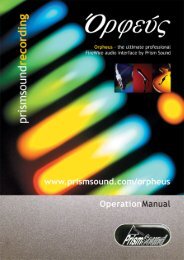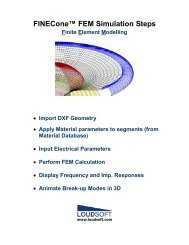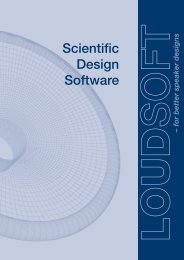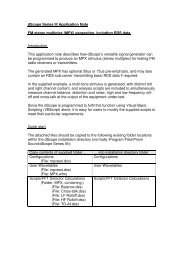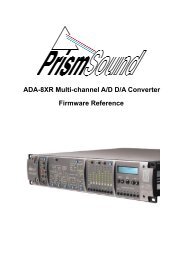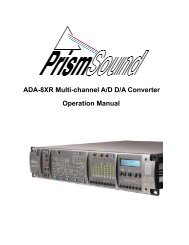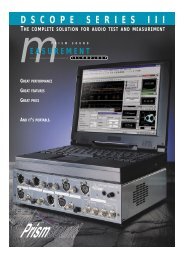ADA-8XR Multi-channel A/D D/A Converter Operation Manual
ADA-8XR Multi-channel A/D D/A Converter Operation Manual
ADA-8XR Multi-channel A/D D/A Converter Operation Manual
You also want an ePaper? Increase the reach of your titles
YUMPU automatically turns print PDFs into web optimized ePapers that Google loves.
Prism Sound <strong>ADA</strong>-<strong>8XR</strong> <strong>Multi</strong>-<strong>channel</strong> A/D D/A <strong>Converter</strong> <strong>Operation</strong> <strong>Manual</strong> - Revision 1.00<br />
two dice with a resultant increase in the probability of medium sized numbers – totals of two<br />
and twelve occur much less often than seven.<br />
7.3.2 Noise shaping<br />
It is possible to reduce the subjective effect of the added dither noise by either using<br />
spectrally weighted ('‘blue'’) dither noise, which is quieter in the more sensitive registers, or by<br />
an even more effective technique called ‘noise shaping’.<br />
Noise shaping is just like conventional dithering, except that the error signal generated when<br />
the unwanted low-order bits are discarded is filtered and subtracted from the input signal.<br />
You can’t get something for nothing – the error cannot be simply cancelled out, because we<br />
already know that the output hasn’t got enough bits to precisely represent the input. But by<br />
choosing an appropriate shape for the error filter, we can force the dither noise / error signal<br />
to adopt the desired shape in the frequency domain – we usually choose a shape which<br />
tracks the low-field perception threshold of the human ear against frequency. As can be seen<br />
from the plots below, this has the effect of actually lowering the noise floor in the more<br />
sensitive frequency bands when compared to the flat dither case.<br />
The theory of noise shaping has been around for a long time – certainly since well before<br />
DSP in real-time was feasible for audio signals. It has applications in many signal processing<br />
and data conversion applications outside audio. It has been well researched, and is not in the<br />
least bit mysterious. ‘Proprietary’ wordlength reduction algorithms are generally conventional<br />
noise shapers. Assuming that the basic implementation and dither levels are correct, the only<br />
significant freedoms available to the designer are to choose the actual shape of the noise<br />
floor, and to decide how to adapt this (if at all) to different sample rates.<br />
7.3.3 Wordlength and the <strong>ADA</strong>-<strong>8XR</strong><br />
The <strong>ADA</strong>-<strong>8XR</strong> provides a comprehensive choice of processes to optimally generate a<br />
reduced output wordlength from an analogue or digital source. It also includes encoding<br />
processes which allow extended wordlengths to be recorded on or transmitted via shorter<br />
wordlength equipment, as described in section 7.4.<br />
These comprise ‘flat’ dithering, plus a selection of four Prism Sound<br />
‘SNS’ (‘Super Noise Shaping’) algorithms. The four SNS algorithms are<br />
designated SNS1 to SNS4, in increasing order of the degree of shaping.<br />
The spectra of the four SNS algorithms are shown below. Note that,<br />
unlike some noise shaping algorithms, SNS spectra are adjusted<br />
automatically to provide optimum subjective advantage at each different<br />
sample rate and wordlength. The spectra are shown below for 16-bit<br />
output, at 44.1kHz, 48kHz and 96kHz sample rates only.<br />
SNS1 provides only a very small subjective noise advantage, but only applies limited noise-lift<br />
at quite high frequencies. In many applications (particularly those where the program material<br />
is already quite noisy) this type of shaper is very often preferred.<br />
SNS2 is a happy medium. It provides a good amount of subjective lowering of the noise floor,<br />
but with addition of only moderate amounts of high-frequency noise. It also has the<br />
advantage that the noise floor remains subjectively white, even when artificially amplified.<br />
SNS3 and SNS4 are ‘optimal’ shaper designs – their shaping is quite extreme in order to get<br />
the maximum theoretical subjective improvement in noise performance based on an average<br />
human low-field sensitivity curve. This results in the addition of larger amounts of highfrequency<br />
noise.<br />
It is difficult to assess the difference in sound between different noise shapers for any given<br />
program material, since their effects are at very low amplitudes (the 0dB line on the plots<br />
© Prism Media Products Limited, 2001-2004 Page 1.29



